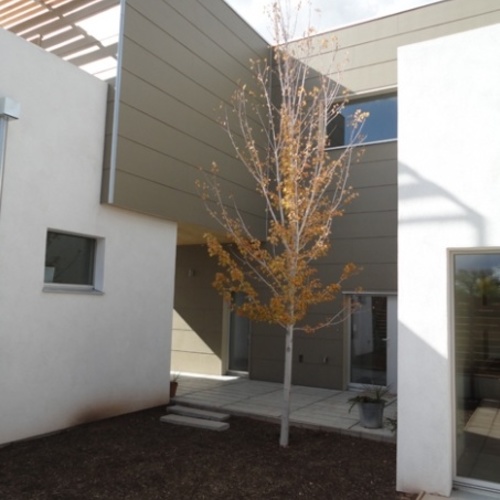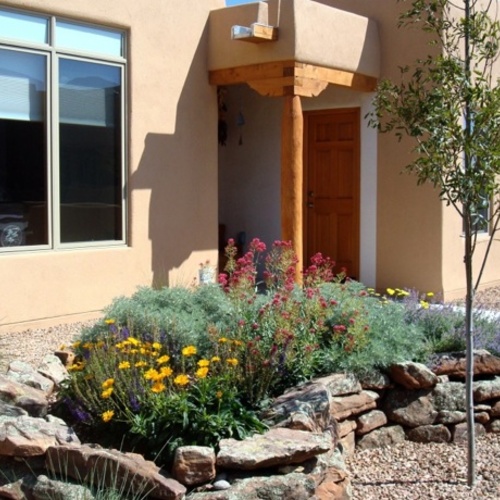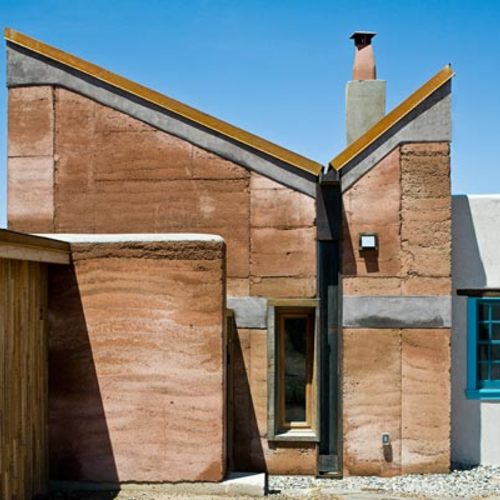
Image Credit: Kreger Design Build
HVAC Group Files Suits Against Code
SANTA FE, NM — The development of a new green building code in Santa Fe has been delayed by a legal challenge to a proposed green building code in Albuquerque. On October 3, 2008, a federal district judge granted a preliminary injunction preventing Albuquerque from implementing its new green building code, which included provisions that might be interpreted as establishing minimum efficiency standards for residential heating and cooling equipment that are more stringent than federal minimum requirements. The injunction was ordered in response to a suit by the Air Conditioning, Heating and Refrigeration Institute (AHRI), an alliance of manufacturers of heating and cooling equipment. AHRI opposes any local regulations that establish more stringent efficiency standards than the federal government. Katherine Mortimer, Santa Fe’s supervising planner, decided to delay implementation of Santa Fe’s proposed green building code until the legal issues raised by the Albuquerque case were clarified.
Green Building Advisor’s Martin Holladay contacted Mortimer, who graciously provided details of the green code development process in Santa Fe. A transcript of the telephone interview follows.
Holladay: When your group in Santa Fe looked at developing a green building code, where did you start?
Mortimer: We looked at several models, including LEED for Homes, and we settled on the NAHB green building standards as a starting point. We used a version of that, like Albuquerque did. Albuquerque made some revisions to the NAHB standards — revisions are actually encouraged by that program.
Holladay: Isn’t NAHB opposed to green building codes?
Mortimer: NAHB continues to oppose any form of mandatory green building code, although there is a minority force among local NAHB chapters that wants to change that. We adopted the NAHB model for a couple of reasons, in part because Albuquerque did. Albuquerque is the biggest city in New Mexico. But we also liked the fact that NAHB encourages incorporating local changes.
Holladay: Does the proposed Santa Fe code include mandatory language?
Mortimer: Under our proposed code, you have to get a certain number of minimum points. We did a pretty significant revision of the NAHB standards. We walked through it with different kinds of homes in mind, and we realized that with the NAHB standards it was easier to get a greater number of points with a forced-air than with a radiant system. We changed that, because radiant heat is very popular here. We have more heating days than cooling days, and because of our dry climate, we have more swamp coolers than air conditioners.
One of the principles we want to see reflected in the code is that energy is probably the most important aspect of green building, because energy use continues over time. In Santa Fe we have some buildings that are over 400 years old. But even if a building only lasts as long as the mortgage — even if it lasts only 30 or 40 years — energy use still represents the most significant environmental impact. So in developing the code, we don’t want to concede any points on energy. In fact, we increased the points awarded for improvements in the building envelope, to encourage those improvements. We also added points for solar orientation and passive solar features, which are very big in Santa Fe.
Holladay: How did the legal challenge to the Albuquerque code affect your plans in Santa Fe?
Mortimer: We intend to require a maximum HERS rating 70. As we developed the code, we had a HERS rater look at an average sized building. We asked, How do you get a building of that size to HERS 70? We wanted to see which approach costs less — upgrading the efficiency of the heating and cooling equipment, or improving the envelope. We’ve also had help from a local nonprofit developer of low-income housing, and they’re putting prices on these options. They found that it makes more sense to improve the building envelope — long before it makes sense to look at equipment efficiency.
With the changes we made to the NAHB standard, we wanted to see whether our proposed program is consistent with the federal rules on preemption of minimum equipment efficiency standards. On the first blush, we were worried that a judge might conclude that it could cost more for a builder who didn’t choose more efficient equipment — a situation that from a legal standpoint would amount to de-facto preemption of the federal standards.
This is a very important legal issue. If requiring a certain HERS score is interpreted by the courts as de-facto preemption of the federal equipment efficiency standards, that probably means that California’s Title 24 is illegal. It also raises questions about whether local water efficiency requirements amount to preemption.
Holladay: What aspect of the Santa Fe code are you particularly proud of?
Mortimer: We have been developing this code hand-in-glove with the building community. We’re working with the local home builders’ association. In fact, three out of the five people in the working group for this new green code are builders. That’s different from the situation in some other communities that have tried this.
The other thing to point out is that we have tailored our code to the way people build here — for example, by encouraging passive solar and adobe. In Santa Fe, most of our residential building is not by production builders. We developed the code to address the concerns of both production builders and custom builders. I’d also like to point out that the code will require a thermal bypass inspection, including an inspection to verify the quality of the insulation job. The concept of the thermal bypass inspection is new to many people in the building community. If you have a corner with no insulation, that’s a huge energy penalty.
Holladay: Will Santa Fe go forward with its new code?
Mortimer: Now that we’ve taken the time to analyze the situation in light of the legal challenge in Albuquerque, we feel more confident going forward. We feel that the evidence shows that our code will not be a de-facto requirement for more efficient heating and cooling equipment.
Weekly Newsletter
Get building science and energy efficiency advice, plus special offers, in your inbox.















2 Comments
Response to Armando
Armando,
Thanks for the update!
Update
FYI, the issue the Air Conditioning, Heating and Refrigeration Institute (AHRI) had with the City of ABQ was that the AECC (I was a member of that committee) required SEER14 min. in 1 out of 4 ways to get a building permit (not the only way), also, their cost claims to remedy retrofits were outrageously misrepresented.
Subsequently, the AECC dropped the SEER14 requirement but increased the envelope requirements and the new code has been in use since last year.
Here is the AECC: http://www.cabq.gov/albuquerquegreen/pdf/volumeII.pdf
Log in or create an account to post a comment.
Sign up Log in